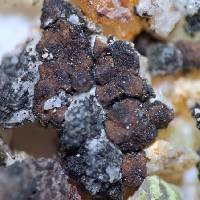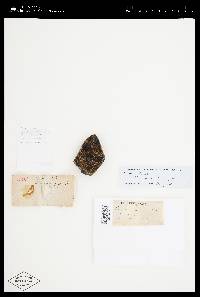
Consortium of Lichen Herbaria
- building a Global Consortium of Bryophytes and Lichens as keystones of cryptobiotic communities -
- Home
- Search
- Images
- Species Checklists
- US States: O-Z >
- US National Parks
- Central America
- South America
- US National Parks
- Southern Subpolar Region
|
|
|
|
Family: Acarosporaceae
[Acarospora dispersa H. Magn.] |
Nash, T.H., Ryan, B.D., Gries, C., Bungartz, F., (eds.) 2007. Lichen Flora of the Greater Sonoran Desert Region. Vol 3. Thallus: areolate, dispersed or somewhat contiguous through vegetative division, overall up to 5 cm or more wide areoles: round to irregularly shaped, 0.3-1(-3) mm in diam., up to c. 1 mm thick; rim: ±down-turned often with a distinct black margin upper surface: yellowish brown to rarely dark brown or grayish brown, dull, plane to convex, epruinose lateral cortices: paraplectenchymatous, 25-100 µm thick; cells: mostly 3-5 µm in diam.; syncortex: thin or absent; eucortex: upper layer dark brown to reddish-brown and c. 10 µm thick, lower layer hyaline, merging into the prosoplectenchyma of hyphal bundles within the algal layer and 15-30 µm thick algal layer: evenly stratified in young or reduced areoles but uneven and jagged in thicker areoles, penetrated by hyphal bundles medulla: white, prosoplectenchymatous, continuous with attaching hyphae lower surface: usually corticate and dark attachment: broad, without forming a stipe Apothecia: punctiform or dilating, up to 0.7 mm in diam., solitary or up to six or eight in dividing areoles disc: usually reddish brown, immersed, rough, epruinose, often surrounded by a reddish stain on the upper surface parathecium: c. 10 µm wide, sometimes expanding near surface epihymenium: yellowish brown, conglutinated, c. 10 µm thick hymenium: hyaline, often yellowish green to red in IKI in Sonoran specimens, 100-200 µm tall; paraphyses: (0.5-)1-1.5(-1.7) µm wide at base, the tips ±expanded becoming 2-3 µm wide, ±septate and constricted in upper third subhymenium: hyaline, ±30 µm thick, usually turning blue in IKI in Sonoran and Mexican specimens; hypothecium: c. 10 µm thick asci: cylindrical to clavate, 100 x 10-25 µm, 100+ spored ascospores: hyaline, simple, ellipsoid, 3-6 x 1-2(-2.5) µm, but various Pycnidia: not seen, but many nascent apothecia occur Spot tests: UV-, all spot tests negative Secondary metabolite: none (TLC, J.C. Lendemer, pers comm.) Substrate and ecology: on sandstone as well as hard acidic rocks World distribution: North America (California, throughout the Ozarks to Ohio) Sonoran distribution: rare in Arizona (San Francisco Peaks) and infrequent in coastal areas in southern California Notes: Acarospora dispersa is a member of A. smaragdula group with an interrupted algal layer, thin paraphyses, and no secondary metabolites. It commonly occurs on hard surfaces and produces a generally dispersed thallus which only becomes crowded as areoles divide. It can only be confused with A. hassei, which has a chasmolithic thallus and somewhat verruculose, dark brown to somewhat translucently elevated, fertile areoles. The author originally included A. dispersa in A. smaragdula as a chemotype until enough specimens were investigated (Knudsen 2005a). Acarospora smaragdula s. str. contains norstictic acid and has multiple apothecia in each fertile areole or dividing unit of an areole. It occurs in Canada and down the coast of eastern North America, often along the shores of the Atlantic Ocean where it is often collected with Acarospora amphibola. |
|
|
|
Powered by Symbiota









































